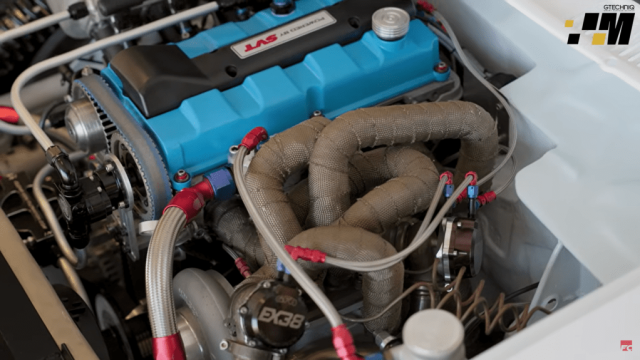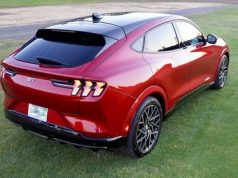Tobias Arkell continually engineered his beloved Ford Zetec Turbo build – a Fiesta XR2i that he’s transformed into a monster-spec, turbocharged ST170 engined, RWD animal. Best of all? It’s a modified car built in his shed!
Great Britain’s shed scene was never meant to fade, and it hasn’t. In our latest Build Masters video sponsored by Gtechniq, we were handed what looked like a mint, factory-spec XR2i and were reminded that proper engineering is still being done at home. A one-lady-owner survivor was bought by Tobias Arkell on his 18th birthday and was quietly planned as a tidy keeper. The plan was derailed in the best way. What began with a CVH ditch and an early Zetec on throttle bodies was pushed further with boost, then rotated ninety degrees into rear-wheel drive. The result has been refined again for 2025: a sleeper-skinned Ford Zetec turbo build with race-car brains and a factory-plus finish.
The ultimate Ford Zetec turbo build: ST170 head, CGI Zetec block, big turbo package
Under the bonnet a simple drop-in was never the brief. An ST170 cylinder head has been mated to a rare CGI (Compacted Graphite Iron) Zetec block, the unicorn casting with extra webbing and reinforced galleries. Stainless intake valves and Inconel exhaust valves have been used, ST cams have been retained, and Area Six springs with reworked followers have been made to play nice. Static compression has been set at 10.0:1 because response has been prioritised over soft, lazy tunes. Custom rods have been specified and the pistons have been home-machined with forced pin oiling, lateral gas ports for ring seal, pocketing for VVT clearance, relieved skirts, and the rotating assembly has been balanced to within a gram. A Ford steel crank with tweaked geometry has been installed to chase a five-figure rev ceiling.
On about 25psi to just shy of 9000rpm, a GSX-R1000 was held from 30–130mph, so 500–550bhp has been the sensible estimate. In a Fiesta that sits around a metric ton with driver, silliness has been guaranteed. E85 supply has been eyed to unlock more timing at that compression, with calibration and boost-by-gear set to be tailored for sprint work rather than dyno theatre.
Intake, exhaust and heat management
The hot side has been through revisions. The first stainless manifold looked like sculpture and radiated like a furnace; a lower-mount V2 has been planned to sit the turbo deeper, reduce heat soak, and simplify a proper cold-feed. The cold side wears a cast-look plenum that started life as a genuine RS1600i inlet for the Ford logo, then was chopped, TIG’d, flap-wheeled and heavy sand-blasted to a factory vibe with RS200 energy. The aesthetic has been kept tidy and OE-plus, which is why bystanders have been seen to stroll past, double-take, then boomerang back for a peek at the external wastegate plumbing.
Drivetrain: from RX-8 ingenuity to sequential aggression
The original rear-drive chapter was drafted with a Mazda RX-8 gearbox, RX-7 open bearings, and a home-machined baffle plate, driving a built English axle via a carbon prop. It worked and it was wild, but the 2025 spec has been cranked up. A proper sequential has been installed under a hand-made tunnel, and the driveline has been matched to the chassis so traction can be put down cleanly rather than fought against. The aim has been speed between corners and repeatability on hot laps, not just one-hit hero pulls.
Suspension and chassis: pushrod front, independent rear
The shell work that defined the early build hasn’t been lost; it has been amplified. Stitch-welding has been done seam-by-seam, the bulkhead has been nudged back for weight distribution, and the nose has been semi-space-framed to tie suspension loads into the cage. Up front, double wishbones with inboard coilovers on pushrods have been fabricated, loosely scaled from touring-car and Hoonicorn geometry, then tuned by feel until the bump curves behaved. Motorsport Tools alloy hubs from an Escort Safari kit have been re-machined for custom pick-ups, and Wilwood six-pots bite 325mm floating rotors.
Out back, the live axle chapter has been closed. A fully independent rear has been built as a bolt-in cradle with twin wishbones and dampers laid over at roughly 45 degrees, giving Escort WRC vibes under Fiesta skin. An R32 Skyline LSD has been tucked beneath the boot, DriveShaft Shop uprated shafts have been used, and a carbon RX-8 prop has been kept to see what it can take. Wilwood four-pots with 310mm floating rotors sit on MK kit-car hubs with Sierra Cosworth-spec bearings, so the back end has been given the backbone it always needed.
Steering, brakes and feel
Early steering leverage that once snapped a Sierra manual rack pinion has been solved with a BMW E46 purple-tag rack fed by an electro-hydraulic pump, with lines routed under-floor for neatness and thermal stability. The result has been manoeuvrable in the paddock and precise at speed. Brake feel has been paired to the chassis balance so the Ford Zetec turbo build could be trail-braked properly rather than tip-toed.
Interior and electronics: race brain, OEM soul
A Safety Devices cage has been stitched into full box-section chassis rails and sent forward to the tube front so the whole shell fights flex as one. Inside, the sequential shifter sits in a tidy tunnel that looks factory-plus rather than afterthought. ECUMaster EMU Black, PMU16 and a digital dash have been wired as the car’s brain, with a bias box, hydraulic clutch and a hydraulic handbrake handling the business. The single wiper has been kept for righteous ’90s cred. So have the electric windows, door cards, headlining and even the sunroof, because sleeper points matter and the street-car soul hasn’t been deleted.
Zetec Turbo performance, reliability and the next steps
Lessons have been learned the hard way. An auxiliary belt mishap that once took the oil-pump drive with it forced a rebuild and created the window to revise piston spec, refine clearances and generally level up the detail. The oil system has been re-thought for longevity, fuel strategy has been pointed at E85, and the turbo is due a size tweak to make it even punchier for hillclimbs. The mission has been simple: a Ford Zetec turbo build that can run all day, not just once.
Ford Fair 2025: Built Not Bought winner
At Ford Fair 2025, the sleeper silhouette did its best work. Forming part of the formidible Fast Ford display, the car was watched, walked past and then swarmed as the details were clocked. “Built Not Bought” was awarded, our Build Masters tee was handed over, and the recognition landed exactly where it belonged: on a Cornish shed floor that has been turned into a world-class skunkworks.
Why this XR2i is the blueprint Ford Zetec turbo build
This project has been engineered, not assembled. It has been balanced for response, not just numbers. It has been designed around hillclimbs, sprints and real seat time, and yet from twenty paces it still reads as a clean XR2i. That is exactly why it hits so hard. The shed spirit hasn’t been replaced by CAD and catalogues; it has been amplified by skill, patience and a refusal to leave “good enough” alone. We were lucky to film the latest iteration; we’re even more excited to see where the next tweak takes it.
Ford Zetec turbo build FAQ
What is a CGI Zetec block and why has it been used? It is a Compacted Graphite Iron casting with extra webbing and strengthened oil galleries, chosen for stiffness and durability under high boost and high rpm. In this case it has been the backbone for the 10.0:1, big-rev package.
How much power does this Ford Zetec turbo build make? On approximately 25psi and revs just shy of 9000rpm, performance has been consistent with a 500–550bhp estimate.
Is the XR2i still road-friendly? The interior has been kept civil where it matters, with electric windows, door cards, headlining and a sunroof still in place, but the driving experience has been set up for track and hillclimb focus with a sequential gearbox, pushrod front end and an independent rear.
What’s next for the build? Fuel strategy on E85, a tighter turbo for hillclimb punch, and continued chassis tuning have been planned so the evolution can keep rolling.
See more cars like this at Ford Fair – Europe’s biggest Blue Oval gathering!
The post RWD Fiesta XR2i — the ultimate Ford Zetec turbo build (Build Masters Feature) appeared first on Fast Car.







